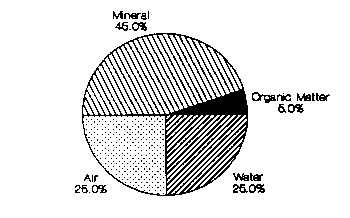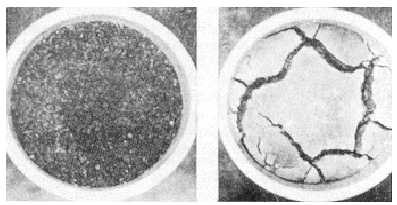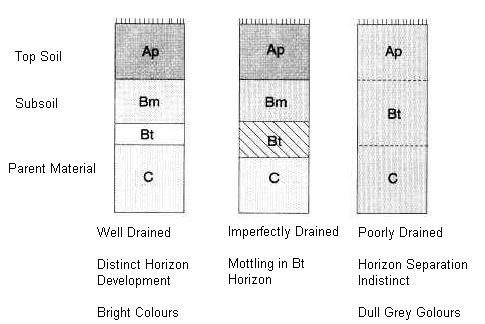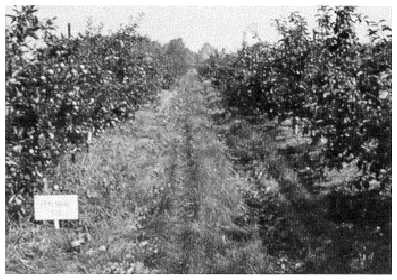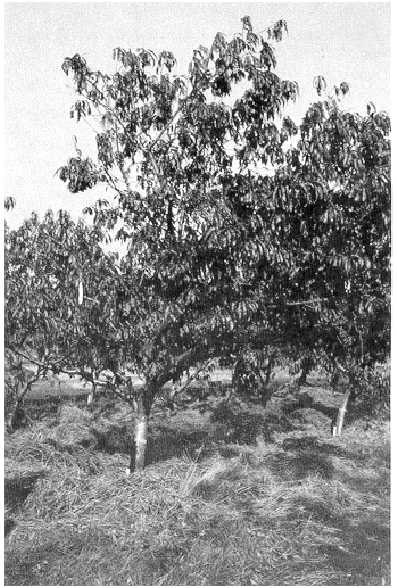Soil management for orchards and vineyards
Learn the ideal soil properties for orchards and vineyards and systems of soil management.
ISSN 1198-712X, Published May 1992
Orchards and vineyards are long-term enterprises. Orchard or vineyard sites must be selected carefully for both soil and climatic conditions. Many important soil properties such as texture (sand, silt, clay), slope, aspect, or depth cannot be changed. Sites having as near to optimum soil conditions as possible should be chosen. In addition to soil factors, the microclimate of the soil can play a very important part in the success of fruit crops. Avoid land with low areas or frost pockets. Low winter temperatures and/or spring frosts can cause reduced yields. Locations with a gentle slope to provide both air and water drainage are preferred to flat sites. Land levelling may be needed to improve these characteristics. This is an added cost, and unless carefully done can reduce the potential productivity of the crop. It is better to select the site carefully than to try to change these characteristics.
Soil Physical Properties
Soil is made up of a solid phase and a space phase (Figure 1). Maintaining a balance between the air and water in the soil is an important challenge of good soil management. Movement of water into and through the soil profile is dependent on the soil type and organic matter content. Organic matter stabilizes soil aggregates, increasing the size of soil pore spaces and the ease of water infiltration and movement. Good soil structure is particularly important on loam and clay loam soils. Good soil management should maintain or increase the organic matter of the soil to improve soil physical properties (Figure 2).
Figure 1. Composition by volume of a typical loam soil.
Figure 2. Good soil management should maintain or increase the organic matter of the soil to improve soil physical properties.
Drainage
Ideal fruit soils have a useable depth for root growth of one metre or more. Many Ontario soils need to be tile drained before planting an orchard or vineyard to ensure proper aeration and depth of rooting. All fruit crops will benefit from systematic tiling if natural drainage is limited and root growth restricted. Peaches and cherries are particularly sensitive to "wet feet." Tiles should be close enough to adequately remove excessive (gravitational) water. In poorly drained clay loam soils, it may be necessary to install a tile line under each row. In other soil types, every other row may be sufficient. Consult a drainage contractor for recommendations and costs.
The natural drainage of the soil can be determined by examining the soil profile (vertical cross-section) (Figure 3). A rusty mottling in the B horizon (subsoil) indicates restricted drainage. Indistinct horizon development could mean poor drainage.
Figure 3. The soil profile can indicate internal soil drainage.
Systems Of Soil Management For Orchards And Vineyards
Cultivation and Cover Crop Systems
Most vineyards and peach orchards in Ontario are cultivated for a portion of the year to eliminate competition between vines or trees and weeds for moisture and nutrients. Cultivation should be started as soon as the soil is dry enough in spring and continued until July 1 for orchards and August 1 for vineyards, after which a cover crop is seeded.
The number of cultivations should be kept to a minimum since cultivation results in soil compaction, oxidation, and loss of organic matter. Cultivation can destroy roots if it is too deep or close to trees.
- Residue from the cover crop, including tops and roots, helps to maintain soil organic matter. Fertilize and mow the cover crop in order to obtain maximum growth and organic matter production.
- Cover crops use nutrients and moisture late in the season to help trees or vines prepare for winter. They also prevent leaching losses by tying up nutrients in organic form over winter.
- A grass cover helps control or prevent erosion. Orchards or vineyards are frequently subject to water erosion because of slopes needed for good air movement. Wind erosion is a problem with bare, coarse-textured soils. A grass cover also supports implements, thereby reducing compaction, which enables tile systems to drain more effectively.
- It is easier to work in the orchard with a grass cover and easier to mow than to cultivate.
Italian Ryegrass is widely used as a cover crop in orchards and vineyards. It germinates quickly, but will remain dormant if there is insufficient moisture. It grows strongly, has a dense root system, and grows well on most soil types. It will trap blowing snow. It needs to be incorporated in early spring or it may be difficult to control. Cultivated soils warm more quickly in spring and radiate heat more readily during frosty nights.
Oil Seed Radish has been more recently used as a cover crop in orchards and vineyards. It is deeper rooted than rye-grass but does not provide as much organic matter nor support for equipment. It may be seeded in a mixture with ryegrass.
Other crops such as rye, oats, or buckwheat have been used as cover crops but are not as suitable as ryegrass. Not planting a cover crop and simply allowing weeds to grow is not as effective as ryegrass and may lead to long-term weed problems. Deep-rooted weeds (like dandelions) can compete directly with tree or vine roots.
Organic Amendments Organic matter broken down by cultivation should be replaced by additions of organic amendments. Generally cover crops do not return sufficient organic matter to maintain soil humus. Examples of organic amendments that might be used and their suggested rates are given in Table 1.
Table 1. Dry Matter and Major Nutrients Added by Suggested Rates of Organic Residues.
Suggested Rate (t/ha) | Dry Matter | N (kg/ha) | P202 | K20 | |
|---|---|---|---|---|---|
Cattle-Mixed Livestock Manure | 25 | 5800 | 120 | 60 | 120 |
Swine Manure | 20 | 5400 | 120 | 100 | 60 |
Poultry Manure | 7 | 2100 | 130 | 130 | 75 |
Timothy Hay | 9 | 8200 | 120 | 42 | 80 |
Alfalfa Hay | 5 | 4600 | 120 | 25 | 100 |
Wheat Straw | 7 | 6300 | 40 | 14 | 70 |
Grape Pomace | 9 | 3300 | 120 | 45 | 150 |
Paper Mill Waste | 30 | 9000 | 110 | 30 | 16 |
The rates are based on nitrogen content and except for wheat straw, supply the same rate of nitrogen. Some materials, such as poultry manure, alfalfa hay, or grape pomace, that are high in nitrogen, should be applied only at low rates, and therefore do not supply sufficient dry matter to maintain soil organic matter. In contrast, nitrogen fertilizer should be applied with wheat straw to provide for its breakdown.
Sod System
A permanent vegetative cover in the orchard offers all of the advantages mentioned for cover crops for the entire year. In addition, since the soil is never cultivated, there is no risk of damage to roots nor breakdown of soil organic matter or soil structure. The soil is continuously protected from erosion. There is no need to annually purchase seed or establish a cover crop. The need for organic amendments is also eliminated. The sod system is suitable for apple, pear and plum. Peaches and grapes may also be grown in sod, but extra care is needed to minimize competition for moisture and nutrients.
Time of Seeding and Sod Establishment
The permanent grass cover may be established before planting the orchard, or in the 3rd or 4th year after planting, as the trees reach cropping age. If the grass is established the year before planting, use a wide (1.5 m) herbicide strip in the tree rows the fall before planting. If the grass is seeded after the orchard is established, apply sufficient nitrogen fertilizer for both the trees and the grass the spring before seeding. Soil test and broadcast the fertilizer needed by the sod. If the soil test indicates a need, apply lime before seeding when the lime can be cultivated into the soil. Seed the grass as shallow as possible, preferably in early September or alternatively in the spring. Keep the seed out of the tree row. Once the grass is established, keep it mowed to minimize competition with the trees or vines for moisture and nutrients. In vineyards, planting a permanent grass in every other row may be a viable alternative to a complete sod system, which may be too competitive.
Suitable Sod Species
Ideally, a sod should:
- grow satisfactorily in partial shade;
- withstand heavy orchard equipment;
- be shallow rooted;
- suppress nematodes and other insects; and
- survive drought and winter conditions.
Grasses or grass-legume mixes are best suited for orchard use.
Creeping Red Fescue
This is a very fine grass that forms a dense sod when it is established. It grows slowly in hot, dry periods and crowds out weeds reasonably well once there is a good stand. It may be somewhat difficult to establish and should be shallow seeded. It has a dense root system and suppresses nematode populations.
Tall Fescue
This grass is a coarse, more vigorously growing grass and requires more mowing than creeping red fescue. It produces an excellent sod but may be more competitive for moisture and nutrients. It is easier to establish than creeping red fescue and survives well on most well- to imperfectly- drained soil types. It also suppresses nematode. New, dwarf-type tall fescues may be more adaptable to orchard sod systems.
Perennial Ryegrass
"Turf-type" perennial ryegrass establishes quickly and crowds out weeds in the spring because it grows well in cool weather (Figure 4). There are dwarf cultivars available that are slower growing and may be suitable for orchard use. Perennial ryegrass may not be as persistent as fescue.
Figure 4. "Turf-type" perennial ryegrass establishes quickly and crowds out weeds in the spring because it grows well in cool weather.
Sod Mixtures
Sod mixtures are often used to gain the advantages of each species. For example, companion grass is a commercial grass mixture which contains 80% Elka perennial ryegrass and 20% Ensylva creeping red fescue. It is reported to be slow growing and flowers late and therefore takes less mowing. Seed is expensive. A legume such as white clover may be included with grass mixture to fix nitrogen, but it is short-lived.
Grass Control
The grass under the spread of the tree branches must be controlled to eliminate competition for moisture and nutrients. Persistent herbicides have made this much easier. A single application in spring will frequently give season-long control. See OMAF Publication 75, Guide to Chemical Weed Control, for current recommendations. Some regrowth of grass in the fall is desirable to retain snow and give some winter root protection.
An excellent, non-chemical way of controlling vegetation under the spread of tree branches is by the use of a mulch (Figure 5). In addition to reducing the competition for nutrients and moisture, the mulch conserves soil moisture by reducing evaporation and adding organic matter. It also adds nutrients such as nitrogen and potassium as it breaks down. The mulch provides higher winter and lower summer soil temperatures. It increases root activity in the surface soil and may also increase microbial activity. Mulch should be applied when there is ample soil moisture. Fall is an ideal application time.
Mouse control by baiting and tree guards is extremely important when mulches are used. Keep the mulch at least 25-30 cm away from the tree trunk.
Hay, straw, and wood chips make excellent mulches. Avoid legume hay that is high in nitrogen. Apply sufficient mulch (15 cm depth) to control vegetation under the tree branches.
Fertilizer for the tree needs to be applied in a band outside the mulch.
Figure 5. An excellent, non-chemical way of controlling vegetation under the spread of tree branches is by the use of a mulch.
Complete Herbicide System
In recent years, all vegetation between tree rows has been controlled in many orchards in England and Europe by the use of herbicides. Trees have responded well to this system, with increased growth, yields and reduced fertilizer requirements. In trials at Vineland, peach trees have performed well with complete herbicide control of vegetation. However, soil organic matter was decreased, leading to questions of long-term effects. The trend away from use of chemicals and possible erosion problems may also limit the desirability of this system as an option for orchard or vineyard soil management.
Summary
Growers have many options in selecting their soil management system for orchards or vineyards. Practices should be selected which favor both soil conservation and successful, long-term production of quality fruit. The effects of erosion, loss of organic matter, and compaction are frequently difficult to overcome and should be avoided by good management practices.
